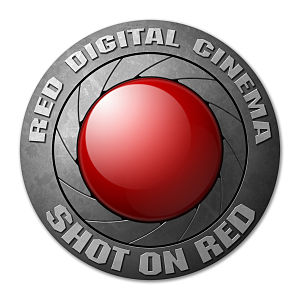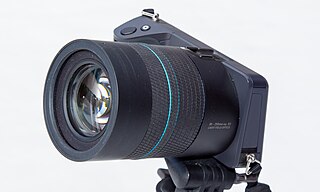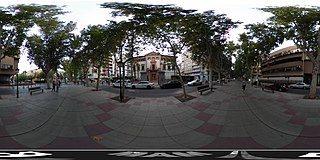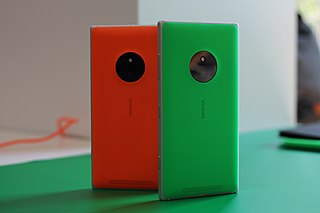
A digital camera, also called a digicam, is a camera that captures photographs in digital memory. Most cameras produced today are digital, largely replacing those that capture images on photographic film or film stock. Digital cameras are now widely incorporated into mobile devices like smartphones with the same or more capabilities and features of dedicated cameras. High-end, high-definition dedicated cameras are still commonly used by professionals and those who desire to take higher-quality photographs.

In photography, bokeh is the aesthetic quality of the blur produced in out-of-focus parts of an image, whether foreground or background or both. It is created by using a wide aperture lens.

A digital single-lens reflex camera is a digital camera that combines the optics and mechanisms of a single-lens reflex camera with a solid-state image sensor and digitally records the images from the sensor.

Red Digital Cinema, LLC is an American camera manufacturer specializing in digital cinematography headquartered in Foothill Ranch, California, United States. It has been owned by Nikon since April 2024.

A light field camera, also known as a plenoptic camera, is a camera that captures information about the light field emanating from a scene; that is, the intensity of light in a scene, and also the precise direction that the light rays are traveling in space. This contrasts with conventional cameras, which record only light intensity at various wavelengths.

Image stabilization (IS) is a family of techniques that reduce blurring associated with the motion of a camera or other imaging device during exposure.
OmniVision Technologies Inc. is an American subsidiary of Chinese semiconductor device and mixed-signal integrated circuit design house Will Semiconductor. The company designs and develops digital imaging products for use in mobile phones, laptops, netbooks webcams, security, entertainment, automotive and medical imaging systems. Headquartered in Santa Clara, California, OmniVision Technologies has offices in the US, Western Europe and Asia.

360-degree videos, also known as surround video, or immersive videos or spherical videos, are video recordings where a view in every direction is recorded at the same time, shot using an omnidirectional camera or a collection of cameras. The term 360x180 can be used to indicate 360° of azimuth and 180° from nadir to zenith. During playback on normal flat display the viewer has control of the viewing direction like a panorama. It can also be played on a display or projectors arranged in a sphere or some part of a sphere.

VR photography is the interactive viewing of panoramic photographs, generally encompassing a 360-degree circle or a spherical view. The results is known as VR photograph, 360-degree photo, photo sphere, or spherical photo, as well as interactive panorama or immersive panorama.

Yi-Ren Ng is a Malaysian American scientist who is an associate professor in the Department of Electrical Engineering & Computer Sciences at the University of California, Berkeley. He was the founder, executive chairman and CEO of Lytro, a Mountain View, California-based startup company. Lytro was developing consumer light-field cameras based on Ng's graduate research at Stanford University. Lytro ceased operations in late March 2018.

A mirrorless camera is a digital camera which, in contrast to DSLRs, does not use a mirror in order to ensure that the image presented to the photographer through the viewfinder is identical to that taken by the camera. They have come to replace DSLRs, which have historically dominated interchangeable lens cameras. Other terms include electronic viewfinder interchangeable lens (EVIL) cameras and compact system cameras (CSCs).

The Nikon 1 series is a discontinued camera line from Nikon, originally announced on 21 September 2011. The cameras utilized Nikon 1-mount lenses, and featured 1" CX format sensors.
Raytrix GmbH is a German company founded by Christian Perwass and Lennart Wietzke that was the first to create and market commercial plenoptic cameras. The R5 camera produces images of 1 megapixel resolution, while the R11 produces 3 megapixel images. Unlike Lytro, which initially targeted the consumer market, the main market of Raytrix's cameras is industrial and scientific applications where depth information of each pixel can be more useful.

The Canon Cinema EOS autofocus digital photographic and cinematographic SLR and mirrorless interchangeable lens camera system was introduced in late 2011 with the Canon EOS C300 and followed by the Canon EOS C500 and Canon EOS 1D C in early 2012.
The Sony Cyber-shot DSC-RX100 series is a high-end compact camera part of the wider Sony RX series. It started with the DSC-RX100, announced on 6 June 2012, and is part of the Cyber-shot RX line of digital cameras made by Sony. Seven annual generations have been released so far until 2019, all equipped with a one-inch 20-Megapixel image sensor and rotary knob around the lens. Filming at up to 1080p at 60fps is supported by the first three generations, the third additionally with 720p at 120fps, and up to 2160p (4K) at 30fps and 1080p at 120fps high frame rate video since the fourth.
The Samsung NX series was a series of APS-C mirrorless interchangeable-lens cameras with Samsung NX lens mounts from Samsung Electronics, introduced in 2010.

The Nokia Lumia 830 is a smartphone developed by Nokia and released by Microsoft Mobile that runs Microsoft's Windows Phone 8.1 operating system. It was announced on September 4, 2014 at Internationale Funkausstellung Berlin, just a few months after Microsoft bought Nokia's mobile division and renamed it Microsoft Mobile. It was released in October 2014. It is a successor to the 2012 Nokia Lumia 820 and marketed as an "affordable flagship".

A virtual reality headset is a head-mounted device that uses 3D near-eye displays and positional tracking to provide a virtual reality environment for the user. VR headsets are widely used with VR video games, but they are also used in other applications, including simulators and trainers. VR headsets typically include a stereoscopic display, stereo sound, and sensors like accelerometers and gyroscopes for tracking the pose of the user's head to match the orientation of the virtual camera with the user's eye positions in the real world. AR headsets are similar to VR headsets, but AR headsets enable the user to see and interact with the outside world. Examples of AR headsets include the Apple Vision Pro and Meta Quest 3.

Daydream is a discontinued virtual reality (VR) platform which was developed by Google, primarily for use with a headset into which a smartphone is inserted. It is available for select phones running the Android mobile operating system that meet the platform's software and hardware requirements. Daydream was announced at the Google I/O developer conference in May 2016, and the first headset, the Daydream View, was released on November 10, 2016. To use the platform, users place their phone into the back of a headset, run Daydream-compatible mobile apps, and view content through the viewer's lenses.
Project Starline is an experimental video communication method currently in development by Google that allows the user to see a 3D model of the person they are communicating with. Google announced the product at its 2021 I/O developer conference, saying that it will allow users to "talk naturally, gesture and make eye contact" by utilizing machine learning, spatial audio, computer vision and real-time compression to create the 3D effect without the user wearing typical virtual reality goggles. The goal is to make the user feel as if they are in the same room with the other user.



















